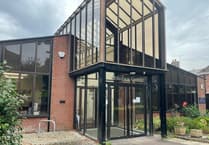ON the evening of April 26, Thorverton History Society members were delighted to welcome John Allan to a full house in Thorverton, to learn about the recent significant works, excavations and projects undertaken in the Quire, the cloister area and the Chapter House of Exeter Cathedral.
As the Consultant Archaeologist to the Dean and Chapter of Exeter Cathedral among his many roles, John is a most informed, enthusiastic and knowledgeable speaker and we were suitably grateful to him to have provided such an exceptional talk to us.
Exeter Cathedral is fortunate to have extensive documented records about both the building and its costs, so that any new discoveries are truly valued as are the increasing applications of new technology to visualise and appreciate them.
The cloisters excavation commenced in 2023 and has allowed for excavation down to Roman levels beneath the medieval deposits.
The cloisters are an amalgam of building styles: Norman, decorated Georgian, Victorian perpendicular, Civil War remnants and some from the Middle Ages.
An ever increasing interest in building materials in addition to the architecture, has established (with the application of digital imagery) that the facades include more than 20 different types of stone and document the chronology of successive periods of renovation and improvement.
Indeed, our cathedral is one of the most studied in Britain.
The recent permissions given to excavate into the foundations has augmented existing knowledge (from work in the 1970s): to establish without doubt the direction of a Roman road beneath the medieval cloisters: expose three Saxon burials on this alignment rather than the later east to west Christian burials and finds of additional stone lined graves of clergy within the fabric of an earlier cloister.
Much of the current cathedral building is attributed to Bishop John Grandisson, who in the 14th century was a very active bishop even though he lived during a time when Exeter was in the grip of the Black Death.
Despite the many challenges that he faced during his long episcopate he was able to make a powerful and lasting impact on both the city and the Church and was responsible for the impressive West Front and the chapel which bears his name.
Now with studies from traditional archival sources, the information derived from soil, stone, buried artefacts and structures, knowledge of the cathedral continues to be extended, as well as innovated with the welcome of the new Cloister Gallery to recreate a covered walkway to once again connect the cathedral with the Chapter House and Pearson Building, to be opened in September.
Another area of works in the cathedral has been the installation of scaffolding to enable access to both study, check and maintain the structure of the fine medieval roof of the 13th century Chapter House to the east of the cloisters. Here the oak wooden beams have been examined, establishing (through dendrochronology) that some were growing as trees in the late Norman period and sourced locally as well as from the Baltic and Ireland.
In addition further insight has been given to fascinating wrought iron work implemented by the Victorians in the early 19th century to maintain the integrity of the roof as well as a study of the painted ceiling.
Lastly, John talked to us about the reflooring of the Quire which has provided a unique opportunity for archaeologists to investigate and dig within the cathedral itself.
There is evidence of a succession of earth and mortar floors and the remains of a high altar have been found as well as an underground feature in the apse which may raise the possibility of catacombs or a reliquary.
A sketch by William Lethaby in 1903 indicated a decorated presbytery floor which has since disappeared. We are fortunate, as part of these works, that a new floor tile design, named the “Jubilee Pavement” has been installed (again based on the work of Sir George Gilbert Scott) as four elaborate tiled floors in the high altar section of the Quire, which opened in April this year.
This was a detailed and in depth vision of both the new changes and historical evidence of such a significant building.
Members were reminded of our upcoming field trip in June to Dunkerswell Airfield.
K A Marshall




